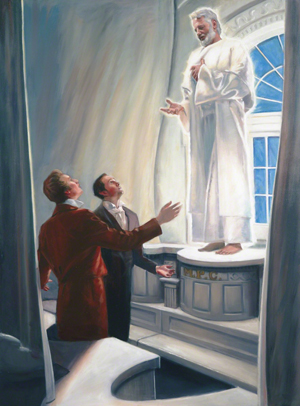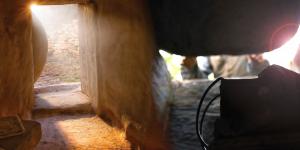You are here
How Do the Bible and Book of Mormon Help Us Understand the Sealing Power?

3 Nephi 25:5-6
The Know
The power to seal marriages and perform other ordinances that would be recognized, or remain in force, “in and after the resurrection from the dead” was given to Joseph Smith “in the last days” (Doctrine and Covenants 132:7). This power was conferred through the visitation of Elijah in the Kirtland Temple on April 3, 1836 (Doctrine and Covenants 110:13–16).
Joseph had been previously instructed multiple times by heavenly beings regarding Elijah’s essential mission to restore these priesthood keys in this final dispensation.1 He would also have encountered the importance of the coming of Elijah in the Book of Mormon as he translated passages such as 3 Nephi 25:5–6.
In that chapter, Jesus Christ himself provided the Nephites with Malachi’s prophecy regarding Elijah’s mission to “turn the heart of the fathers to the children, and the heart of the children to their fathers” before “the coming of the great and dreadful day of the Lord.” This prophecy was of such importance to “future generations” that the Father, in his wisdom, “commanded that [Christ] should give” it to the Nephites to be recorded in their sacred records (3 Nephi 26:2).
Many Latter-day Saints are aware that the sealing power of the priesthood was entrusted to Elijah, who was given the mission to restore that power in the last days, before Christ’s second coming. However, the biblical record also contains several important traditions concerning the sealing power.
Matthew 16:19 is a well-known passage in which Jesus declared to his disciple Peter: “And I will give unto thee the keys of the kingdom of heaven: and whatsoever thou shalt bind on earth shall be bound in heaven: and whatsoever thou shalt loose on earth shall be loosed in heaven.” The keys mentioned here seem to symbolize those that open the doors to the kingdom of heaven and to hell (Hades). This is likely a reference to the idea that priesthood authority is needed to open the doors of heaven to let persons in, as well as to open the gates of hell to let persons out
Revelation 1:18 makes reference to these same keys, wielded by Jesus Christ himself. The Lord declared: “I am he that liveth, and was dead; and, behold, I am alive for evermore, Amen; and have the keys of hell and of death.” The association with the Resurrection is apparent. Furthermore, Christ later referred to Himself as “he that hath the key of David, he that openeth, and no man shutteth; and shutteth, and no man openeth” (Revelation 3:7).
This passage from Revelation is a quotation of Isaiah 22:22, where the Lord said: “And the key of the house of David will I lay upon his shoulder; so he shall open, and none shall shut; and he shall shut, and none shall open.” The Lord was speaking of a man named Eliakim, whom He would appoint to be the “grand vizier” of King Hezekiah’s court (see 2 Kings 18:18). One of his duties was apparently to control who could enter the doors of the royal palace. The attribution of this authority to the resurrected Jesus in the New Testament demonstrates a tradition of interpreting these “keys” as a type or foreshadowing of the Messiah’s authority.
According to Jewish tradition, only God Himself held all the keys, including the keys of birth, rain, and resurrection. When Elijah declared that, according to his word, there would be no rain, it was because God had given him the keys to close the heavens. He was then able to raise the widow’s son (1 Kings 17:23), the Rabbis suggested, because God had given him the keys to the resurrection.2 This implies that Elijah had been given the keys to the gates of Hades, which is reminiscent of Christ’s declaration in Revelation 1:8.3
The Book of Mormon remains faithful to this ancient tradition when it describes sealing powers given to Nephi, the son of Helaman. Like Elijah, Nephi called upon the Lord to control the rain, “according to my words” (Helaman 11:4, 13). Another interesting parallel is found when Nephi’s son, Nephi, raises his brother from the dead (3 Nephi 7:19). In Helaman 10, the Lord declared to Nephi that He would give him “power, that whatsoever ye shall seal on earth shall be sealed in heaven; and whatsoever ye shall loose on earth shall be loosed in heaven” (Helaman 10:7). The language used in this chapter, which also contains subtle temple imagery, is reminiscent of both the situations of Elijah and Peter.4
Furthermore, the Book of Mormon provides additional examples of ideas surrounding “sealing” that are mentioned only briefly in the Bible. For example, King Benjamin talks about being “steadfast and immovable, always abounding in good works, that Christ … may seal you his, that you may be brought to heaven, that ye may have everlasting salvation and eternal life” (Mosiah 5:15; cf. Alma 34:35). This concept of sealing seems to be related to the “seal” marked on the foreheads of the righteous in Ezekiel 9:4 and Revelation 7:2–4, which was given to save them from destruction (cf. Exodus 12:13, 22–24) and preserve them for God’s purposes.
In addition, and likely conceptually related, ancient documents that were held to be highly important and legally binding were sealed with an official seal (see Jeremiah 32:9–14). According to LDS scholar John W. Welch, only a judge or other official who had the proper authority could break the seal in order to view the contents for use in court.5 In similar fashion, we read in the Book of Mormon of Nephi sealing his words, so that they may be used at the “judgment bar” of God (2 Nephi 33:15). Moroni, as he was recording his final words on the gold plates, declared: “And I seal up these records …” (Moroni 10:2).6
The Why
It is important for modern readers to recognize the influence of the Old Testament story of the prophet Elijah on the Book of Mormon narrative. The memory of Elijah receiving the keys to seal up the heavens and to bring the living back from the dead reverberated throughout scriptural history.
Elijah was considered one of the greatest prophets of all time, and was prophesied to be sent to usher in the coming of the great and dreadful day of the Lord (Malachi 4:5). Elijah’s coming was so highly anticipated that some in Jesus’ day who learned of the Savior’s miraculous ministry thought that He was Elijah (Matthew 16:14; Mark 8:28). Elijah’s presence at the Mount of Transfiguration further demonstrates the importance of his priesthood keys (Matthew 17:3).
Jesus was commanded by the Father to instruct the Nephites regarding the future coming of Elijah (3 Nephi 25:5), ensuring that they, and future readers of the Book of Mormon, would understand his essential mission. Furthermore, Mormon apparently shaped his abridgment of the story of Nephi to parallel the story of Elijah.7
The priesthood keys that Elijah was given were passed on to The Church of Jesus Christ of Latter-day Saints when Elijah appeared to Joseph Smith and Oliver Cowdery. Regarding the mission of Elijah in these latter days, Joseph Smith taught:
The doctrine or sealing power of Elijah is as follows:—If you have power to seal on earth and in heaven, then we should be wise. The first thing you do, go and seal on earth your sons and daughters unto yourself, and yourself unto your fathers in eternal glory.8
Readers of the Book of Mormon can gain understanding of the sealing power from the ancient practice of sealing books—and persons—by those who have the proper authority. Only an authorized official could seal up a record or break a seal. The Book of Mormon authors understood this concept well, and knew that their writings would be sealed up, kept safe, and used by God in the final judgment. In similar fashion, the authority of the priesthood can seal up persons, preserving them from the destructive power of Satan and binding them to each other and to God for eternity.
Further Reading
Book of Mormon Central, “How Did Nephi Use the Power to Seal on Earth and in Heaven? (Helaman 11:4),” KnoWhy 182 (September 7, 2016).
A. Keith Thompson, “Joseph Smith and the Doctrine of Sealing,” Interpreter: A Journal of Mormon Scripture 21 (2016): 1–21.
S. Kent Brown, “Peter’s Keys,” in The Ministry of Peter, the Chief Apostle, ed. Frank F. Judd Jr., Eric D. Huntsman, and Shon D. Hopkin (Provo, UT: Religious Studies Center; Salt Lake City: Deseret Book, 2014), 91–102.
John W. Welch, “Doubled, Sealed, Witnessed Documents: From the Ancient World to the Book of Mormon,” in Mormons, Scripture, and the Ancient World Studies in Honor of John L. Sorenson, ed. Davis Bitton (Provo, UT: FARMS, 1998), 391–444.
- 1. Joseph Smith—History 1:36–39; Doctrine and Covenants 2:1; 27:9.
- 2. Babylonian Talmud, tractate Sanhedrin, 113a.
- 3. In ancient times, the term Hades was often used to refer to the realm of the dead in general. In light of this access to the realm of the dead, we should note that Joseph Smith explicitly associates the mission of Elijah with baptism for the dead (Doctrine and Covenants 128:17).
- 4. For more comparisons between Nephi and Elijah, see Book of Mormon Central, “How Did Nephi Use the Power to Seal on Earth and in Heaven? (Helaman 11:4),” KnoWhy 182 (September 7, 2016). For more on the temple imagery in Helaman 10, see Book of Mormon Central, “Why is There Temple Imagery in Helaman 10? (Helaman 10:8),” KnoWhy 17 (January 22, 2016).
- 5. John W. Welch, “Doubled, Sealed, Witnessed Documents: From the Ancient World to the Book of Mormon,” in Mormons, Scripture, and the Ancient World Studies in Honor of John L. Sorenson, ed. Davis Bitton (Provo, UT: FARMS, 1998), 397, 403.
- 6. See also Book of Mormon Title Page; 2 Nephi 26:17; 27:7–21; 30:3; Ether 3:27; 4:5; 5:1; Book of Mormon Central, “Why Would a Book Be Sealed? (2 Nephi 27:10),” KnoWhy 53 (March 14, 2016);
- 7. See Book of Mormon Central, “How Did Nephi Use the Power to Seal on Earth and in Heaven? (Helaman 11:4),” KnoWhy 182 (September 7, 2016).
- 8. Joseph Smith, Teachings of the Prophet Joseph Smith, comp. Joseph Fielding Smith (Salt Lake City: Deseret Book, 1938), 337–338.
KnoWhy Citation
Related KnoWhys
Subscribe
Get the latest updates on Book of Mormon topics and research for free







